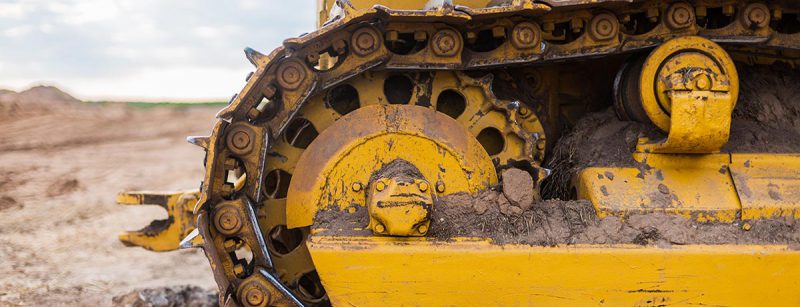
Excavators need constant maintenance so they can optimally perform their work. While operators usually have standard inspection and maintenance schedules for things like greasing attachment bearings and changing dirty hydraulic filters, the undercarriage of the excavator can often be forgotten and neglected. Even though it is not readily visible, the undercarriage goes through conditions that can be pretty extreme based on the work, the handling of the operator, and ground conditions. Here are 6 tips to maintaining your excavator’s undercarriage:
1. Clean Up the Undercarriage
You won’t be able to spot problems if the undercarriage is covered in dirt and mud. Left uncleaned, the accumulation of materials underneath the excavator will build up and rub against the metal bolts, gears, and rollers, eroding the metal. If the temperature drops, the dirt and mud freeze, which speeds up that wear and tear. The added weight of dirt and debris also reduces the fuel economy on the excavator.
To clean the excavator undercarriage, you’ll want to park the machine in a wash pit to prevent dirty water that may contain grease and other contaminants from entering potable water resources. Remove the attachments and clean off the dirt and mud with a shovel. Then prewash the machine by starting with the tires or tracks and working inward. Next, manually remove grease accumulations and pressure wash the equipment before giving it a final rinse.
2. Perform a Full Inspection
With the machine clean, you’ll be able to spot any small or serious problems. Undercarriage inspections should focus on any areas that have excessive wear and tear, uneven wearing on one side, cracked or torn tracks, missing parts, or other damage. You’ll want to focus on any rock guards on the machine, and then check the drive mechanisms (motor and sprockets) and track components (idlers, rollers, bolts, shoes, chains, and tension). Also, look for any oil leakage that could be an indication of a cracked seal.
3. Change Out High-Wear Parts
During the inspection, you may have noticed some parts that have experienced high wear and tear. Three main parts undergo excessive rates of wear:
- the idler,
- the sprockets, and
- the rollers.
Front and rear idlers may have teeth that have worn down to a rounded shape. The same problem happens with the sprockets. You may see that the teeth are jagged, missing, hooked, pointed, or misshapen in other ways. When inspecting the bottom roller on the excavator, the roller may have seized or loosened which could damage the track. If you see any significant damage or wear, replace all worn components.
4. Grease Relevant Parts
Grease is the lifeblood of your excavator, allowing it to move and work at its optimal level, and every excavator has grease points along the undercarriage. Greasing all bearings and fittings ensures smoother operation and helps the machine keep dirt out of various components. The manufacturer’s manual will provide details regarding where to locate each grease point and the amount of lubrication these points should have during daily inspections.
5. Obtain Proper Track Tensioning
Since you already have the grease gun out to grease the bearings, now is the perfect time to check the track tensioning. Track tension improves the health of the undercarriage by providing better handling of the machine when the operator moves it over different terrain. If the track is too loose, it will slip off the machine. If the track is too tight, it will cause more excessive wear to the track and could blow out the bushings.
While the owner’s manual will state the type of tension the track should have, also keep the operator’s experience in mind. Some experienced operators can handle a looser track, as this technique can prolong the track’s lifespan. Less experienced operators may need a tighter track for increased handling. The grease in the adjuster cylinder regulates track tension, so injecting grease will tighten the track and releasing grease will loosen the track.
6. Perform Maintenance on the Rest of the Excavator
You shouldn’t just focus on one main area of the excavator, whether that is the undercarriage, engine, or hydraulic operations. Each component ensures that the entire machine operates as specified. When one area starts to fail, it places increased work on other areas of the heavy machine and causes them to wear out faster. Servicing all components equally prevents neglect that could lead to significant malfunctions and failure later on at the job site.
The undercarriage of the excavator plays a significant role in the operation of your machine. Without proper maintenance, you’ll have a piece of equipment that can’t move its tracks. Avoid breakdowns by creating a heavy equipment maintenance schedule based on how often the excavator is placed into service and maintain those records to predict when you may need replacement parts. Follow these tips — along with the manufacturer’s manual — to perform proper maintenance on the undercarriage, as well as other areas of the machine.